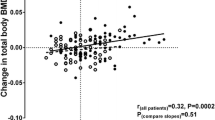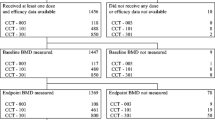Abstract
Understanding factors associated with more rapid bone mineral loss among aging women is important for establishing preventive strategies for intervention. This study reports factors associated with the 5-year change in radial bone mineral density (BMD) determined prospectively in 435 women aged 55–80 years at baseline. The baseline study included measurement of radial BMD (gm/cm2) by single photon densitometry and personal interview. The baseline protocol was replicated 5 years later in a follow-up study. Women with a lower baseline weight or Quetelet index, smaller triceps skinfold and less arm muscle area had significantly greater 5-year bone loss (p=0.001). Current users of estrogens had less radial bone loss (2.8% vs 7.3%,p=0.0005) than women not currently using estrogens. Current users of estrogen had significantly less 5-year loss if use had been for 5 years or longer (−1.0% vs −6.9%,p=0.05). Current users of the thiazide class of medications had less 5-year radial bone loss (5.0% vs 7.4%,p=0.0035) than women without current thiazide use. Baseline dietary calcium, alcohol consumption and smoking were not associated with BMD change. This suggests that greater body size, and current use of estrogens or thiazide antihypertensives are associated with less radial bone mass loss in a 5-year period among postmenopausal women.
Similar content being viewed by others
References
Melton LJ III. Epidemiology of fractures. In: Riggs BL, Melton LJ III, editors. Osteoporosis: etiology, diagnosis, and management. New York: Raven Press, 1988:133–54.
Holbrook TL, Grazier K, Kelsey JL, et al. The frequency of occurrence, impact, and cost of selected musculoskeletal conditions in the United States. Chicago, IL: American Academy of Orthopaedic Surgeons, 1984:1–187.
Mack TM, Ross RK. A current perception of HRT risks and benefits. In: DeLuca HF, Mazess R, editors. Osteoporosis: physiological basis, assessment, and treatment. Madison, WI: University of Wisconsin, 1990:161–78. (Proceedings of the 19th Steenbock Symposium, Madison, Wisconsin, 5–8 June 1989.)
Johnston CC, Jr., Norton JA, Khairi RA, Longcope C. Age-related bone loss. In: Barzel U, editor. Osteoporosis II. New York: Grune and Stratton, 1979:91–100.
Hui SL, Wiske PS, Norton JA, Johnston CC, Jr. A prospective study of change in bone mass with age in postmenopausal women. J Chronic Dis 1982;35:715–25.
Davis JW, Ross PD, Wasnich RD, Maclean CJ, Vogel JM. Comparison of cross-sectional and longitudinal measurements of age-related changes in bone mineral content. J Bone Miner Res 1989;4:351–7.
Riggs BL, Wahner HW, Melton LJ III, et al. Rates of bone loss in the appendicular and axial skeletons of women: evidence of substantial vertebral bone loss before menopause. J Clin Invest 1986;77:1487–91.
Ruegsegger P, Dambacher MA, Ruegsegger E, Fischer JA, Anliker M. Bone loss in premenopausal and postmenopausal women. J Bone Joint Surg [Am] 1984;66:1015–23.
Sowers MF, Clark K, Wallace R, Jannausch M, Lemke J. Prospective study of radial bone mineral density in a geographically defined population of postmenopausal Caucasian women. Calcif Tissue Int 1991;48:232–9.
Sowers MFR, Wallace RB, Lemke JH. The relationship of bone mass and fracture history to fluoride and calcium intake: a study of three communities. Am J Clin Nutr 1986;44:889–98.
Southgate PPA, Southgate DAT editors. McCance and Widdowson's composition of foods. 4th edition. Amsterdam: Elsevier/North-Holland Biomedical Press, 1978.
Block G, Hartman AM, Dresser CM, et al. A data-based approach to diet questionnaire design and test. Am J Epidemiol 1986;123:453–69.
Schlesselman JJ. Case-control studies: design, conduct, analysis. New York: Oxford University Press, 1982.
Kleinbaum DG, Kupper LL. Applied regression analysis and other multivariable methods. North Scituate, MA: Duxbury Press, 1988.
Riggs BL, Melton LJ. The prevention and treatment of osteoporosis. N Engl J Med 1992;327:620–7.
Lindsey R. Sex steroids in the pathogenesis and prevention of osteoporosis. In Riggs BL, Melton LJ, editors. Osteoporosis: etiology, diagnosis, and management. New York: Raven Press, 1988:333–58.
Lindsay R, Tohme JF. Estrogen treatment of patients with established postmenopausal osteoporosis. Obstet Gynecol 1990;72:290–5.
Savvos M, Studd JWW, Normon S, et al. Increase in bone mass after one year of percutaneous oestradiol and testosterone implants in post-menopausal women who have previously received long-term oral estrogens. Br J Obstet Gynecol 1992;99:757–60.
Spector TD, Brennan P, Harris PA, et al. Do current regimes of hormone replacement therapy protect against subsequent fracture? Osteoporosis Int 1992;2:219–24.
Ivanovich P, Fellows H, Rich C. The absorption of calcium carbonate. Ann Intern Med 1967;66:917–23.
Sowers MFR, Wallace RB, Lemke JH. Correlates of mid-radius bone density among postmenopausal women: a community study. Am J Clin Nutr 1985;41:1045–53.
Wasnich RD, Benfante RJ, Yano K, Heilbrun L, Vogel JM. Thiazide effect on the mineral content of bone. N Engl J Med 1983;309:344–7.
Transbol I, Christianson GF, Jensen GF, Christensen C, McNair P. Thiazide for the postponement of postmenopausal bone loss. Metabolism 1982;31:383–6.
Siiteri PK, MacDonald PC. Role of extraglandular estrogen in human endocrinology. In: Greep RO, Astwood E, editors. Handbook of physiology: endocrinology. Washington, DC: American Physiological Society, 1973;615–22.
Ribot C, Tremollieres F, Pouilles JM, et al. Obesity and postmenopausal bone loss: the influence of obesity on vertebral density and bone turnover in postmenopausal women. Bone 1987:8:327–31.
Cumming RG. Calcium intake and bone mass: a quantitative review of evidence. Calcif Tissue Int 1990;47:194–201.
Dawson-Hughes B, Dallal GE, Krall EA, Sadowski L, Sahyoun N, Tannebaum S. A controlled trial of the effect of calcium supplementation on bone density in postmenopausal women. N Engl J Med 1990:232:878–83.
Sempos CT, Johnson NE, Smith EL, Gilligan C. Effect of intraindividual and interindividual variation in repeated dietary records. Am J Epidemiol 1985;121:120–30.
Falch JA, Sandvik L. Perimenopausal appendicular bone loss: a 10-year prospective study. Bone 1990;11:425–8.
Author information
Authors and Affiliations
Rights and permissions
About this article
Cite this article
Sowers, M.R., Clark, M.K., Jannausch, M.L. et al. Body size, estrogen use and thiazide diuretic use affect 5-year radial bone loss in postmenopausal women. Osteoporosis Int 3, 314–321 (1993). https://doi.org/10.1007/BF01637317
Received:
Accepted:
Issue Date:
DOI: https://doi.org/10.1007/BF01637317




